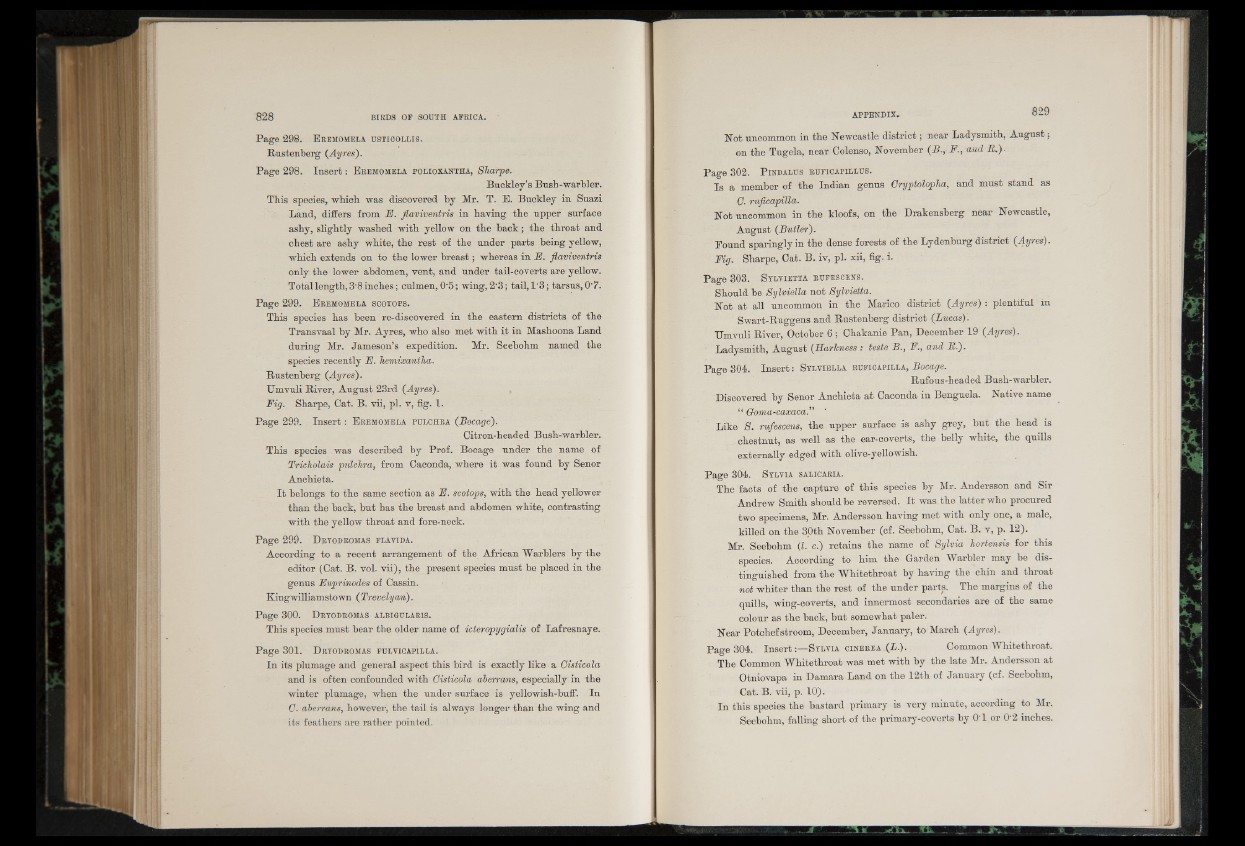
Page 298. E rem om e la u s t i c o l l i s .
Rustenberg (Ayres).
Page 298. In s e r t: E r em om e la p o l io x a n th a , Sharpe.
Buckley’s Bush-warbler.
This species, which was discovered by Mr. T. E. Buckley in Suazi
Land, differs from E. flaviventris in having the upper surface
ashy, slightly washed with yellow on the b a ck ; the throat and
chest are ashy white, the rest of the under parts being yellow,
which extends on to the lower b re a st; whereas in E. flaviventris
only the lower abdomen, vent, and under tail-coverts are yellow.
Total length, 3‘8 inches; culmen,05; wing, 2’3 ; tail, 1'3; tarsus, 0'7.
Page 299. E r em om e la s c o to p s .
This species has been re-discovered in the eastern districts of the
Transvaal by Mr. Ayres, who also met with it in Mashoona Land
during Mr. Jameson’s expedition. Mr. Seebohm named the
species recently E. hemixantha.
Rustenberg (Ayres).
TTmvuli River, August 23rd (Ayres).
Fig. Sharpe, Cat. B. vii, pi. v, fig. 1.
Page 299. In s e r t: E r em om e la p u l c h r a (Bocage).
Citron-headed Bush-warbler.
This species was described by Prof. Bocage under the name of
Tricholais pulchra, from Caconda, where it was found by Senor
Anchieta.
I t belongs to the same section as E. scotops, with the head yellower
than the back, bu t has the breast and abdomen white, contrasting
with the yellow throat and fore-neck.
Page 299. D ry o d rom a s f l a v td a .
According to a recent arrangement of the African Warblers by the
editor (Cat. B. vol. vii), the present species must be placed in the
genus Euprinodes of Cassin.
Kingwilliamstown (Trevelyan).
Page 300. D ry o d rom a s a lb i g u l a r i s .
This species must bear the older name of icteropygialis of Lafresnaye.
Page 301. D ry o d rom a s f u l v i c a p i l l a .
In its plumage and general aspect this bird is exactly like a Gisticola
and is often confounded with Gisticola aberrans, especially in the
winter plumage, when the under surface is yellowish-buff. In
G. aberrans, however, the tail is always longer than the wing and
its feathers are rather pointed.
Hot uncommon in the Newcastle d is tric t; near Ladysmith, August;
on the Tugela, near Colenso, November (B., F., and B.) ■
Page 302. P i n d a lu s r u f i c a p i l l u s .
Is a member of the Indian genus Gryptolopha, and must stand as
G. ruficapilla.
Not uncommon in the kloofs, on the Drakensberg near Newcastle,
August (Butler).
Found sparingly in the dense forests of the Lydenburg district (Ayres).
Fig. Sharpe, Cat. B. iv, pi. xii, fig. i.
Page 303. S y l v i e t t a r u f e s o e n s .
Should be Sylviella not Sylvietta.
Not at all uncommon in the Marico district (Ayres) : plentiful in
Swart-Ruggens and Rustenberg district (Lucas)'.
Umvuli River, October 6 ; Chakanie Pan, December 19 (Ayres).
Ladysmith, August (Earkness : teste B., F., and JR.).
Page 304. In s e rt: S y l v i e l l a r u f i c a p i l l a , Bocage.
Rufous-headed Bush-warbler.
Discovered by Senor Anchieta a t Caconda in Benguela. Native name
“ Goma-caxaca."
Like S. rufescens, the upper surface is ashy grey, bu t the head is
chestnut, as well as the ear-coverts, the belly white, the quills
externally edged with olive-yellowish.
Page 304. S y lv i a s a l ic a r l a .
The facts of the capture of this species by Mr. Andersson and Sir
Andrew Smith should be reversed. I t was the latter who procured
two specimens, Mr. Andersson having met with only one, a male,
killed on the 3_0th November (cf. Seebohm, Cat. B. v, p. 12).
Mr. Seebohm (I. c.) retains the name of Sylvia hortensis for this
species. According to him the Garden Warbler may be distinguished
from the Whitethroat by having the chin and throat
not whiter than the rest of the under parts. The margins of the
quills, wing-coverts, and innermost secondaries are of the same
colour as the back, but somewhat paler.
Near Potchefstroom, December, January, to March (Ayres).
Page 304. In se rt:—S y lv ia c in e r e a (L.). Common Whitethroat.
The Common Whitethroat was met with by the late Mr. Andersson a t
Otniovapa in Damara Land on the 12th of January (cf. Seebohm,
Cat. B. vii, p. 10).
In this species the bastard primary is very minute, according to Mr.
Seebohm, -falling short of the primary-coverts by 0T or 0-2 inches.